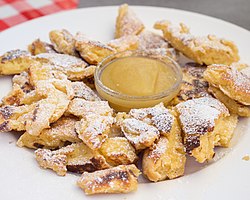Kaiserschmarrn
 Kaiserschmarrn with apple sauce | |
| Type | Pancake |
|---|---|
| Place of origin | Austria-Hungary |
| Main ingredients | Flour, eggs, sugar, milk, butter |

Kaiserschmarrn (German pronunciation: [ˈkaɪzɐˌʃmaʁn] ) or Kaiserschmarren (German: [ˈkaɪzɐˌʃmaʁən] ;[1] 'Emperor's Mess')[2] is a lightly sweetened pancake that takes its name from the Austrian emperor (Kaiser) Franz Joseph I, who was fond of this fluffy shredded pancake. It is served as a dessert or as a light lunch alongside apple sauce and contains raisins or dried cranberries.
Kaiserschmarrn is a popular meal or dessert in Austria, Bavaria, and many parts of the former Austro-Hungarian empire, e.g. Hungary, Slovenia, Czech Republic and northern Croatia, which usually use the name as a loan word or translations of it. In Slovenia, it is called cesarski praženec or šmorn. Its Hungarian name is császármorzsa [3][4] or smarni;[4] its Czech name is (Císařský) trhanec or kajzršmorn. In Slovak it is called Cisársky trhanec.
Etymology
[edit]The name Kaiserschmarrn is a compound of the words Kaiser ('emperor') and Schmarren (a scrambled or shredded dish). Schmarren is also a colloquialism used in Austrian and Bavarian to mean 'trifle, mishmash, mess, rubbish, nonsense'. The word Schmarren may be related to scharren ('to scrape') and schmieren ('to smear' [see schmear]).[citation needed]
Description
[edit]

Kaiserschmarrn is a light, caramelized pancake made from a sweet batter using flour, eggs, sugar, salt, and milk, fried in butter. Kaiserschmarrn can be prepared in different ways. When making Kaiserschmarrn the egg whites are usually separated from the yolk and beaten until stiff; then the flour and the yolks are mixed with sugar, and the other ingredients are added, including: nuts, cherries, plums, apple jam, or small pieces of apple, or caramelized raisins and slivered almonds. The latter ingredients (nuts, cherries, plums, apple jam, or small pieces of apple, or caramelized raisins and chopped almonds) are not part of the original recipe, but additions made by cooks based on their personal preferences. The original recipe only includes rum-soaked raisins.
The pancake is shredded using two forks during frying and usually sprinkled with powdered sugar, then served hot with apple or plum sauce or various fruit compotes, including plum, lingonberry, strawberry, or apple. Kaiserschmarrn is eaten like a dessert, or it can also be eaten for lunch at tourist places like mountainside restaurants and taverns in the Austrian Alps, as a filling meal.
Traditionally, Kaiserschmarrn is accompanied with Zwetschgenröster, a fruit compote made out of plums.
Varieties
[edit]A number of varieties exist, including Erdäpfelschmarrn (with potatoes), Äpfelschmarrn (with apples) or Kirschschmarren (with cherries), usually prepared on an open fireplace of a so-called Rauchkuchl.
History
[edit]
It is generally agreed that the dish was first prepared for the Austrian Emperor Francis Joseph I (1830–1916). There are several stories. One apocryphal story involves the Emperor and his wife, Elisabeth of Bavaria, of the House of Wittelsbach. Obsessed with maintaining a minimal waistline, Empress Elisabeth directed the royal chef to prepare only light desserts for her, much to the dismay and annoyance of her notoriously austere husband. Upon being presented with the chef's confection, she found it too rich and refused to eat it. The exasperated Francis Joseph quipped, "Now let me see what 'Schmarren' our chef has cooked up." It met his approval as he finished his and even his wife's serving.[5]
Another popular tale is that his wife was a poor cook and was not adept at flipping a pancake. She decided to play to her strengths and shred the pancakes instead and would serve them up to the Kaiser regularly with jam. He liked them with jam. It was his favorite dessert.[6][failed verification]
References
[edit]- ^ Sheraton, Mimi (2002). The German Cookbook. New York: Random House.
- ^ Meehan, Monica; von Baich, Maria: Tante Hertha's Viennese Kitchen; New Holland Publishers (UK) Ltd.; London, Cape Town, Sydney, Auckland; 2011; page 148
- ^ June Meyers Authentic Hungarian Heirloom Recipes Cookbook
- ^ a b "smarni | Magyar etimológiai szótár". www.arcanum.com (in Hungarian). Retrieved 2023-09-20.
- ^ Meehan, Monica; von Baich, Maria: Tante Hertha's Viennese Kitchen; New Holland Publishers (UK) Ltd.; London, Cape Town, Sydney, Auckland; 2011; page 148 (Kaiserschmarren)
- ^ "Contact - Kaisy's Delights". Archived from the original on 2015-07-07. Retrieved 2015-07-06.
